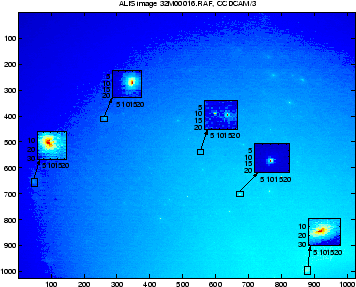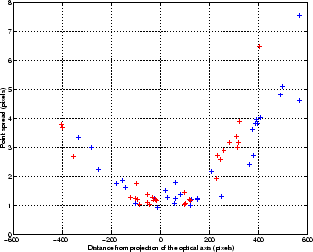
Next: Pixel sensitivity Up: The Forward model - Previous: Shutter characteristics Contents
Point spread function
For imaging with a medium wide field-of-view, such as in the
optics used by ALIS
with field-of-view in the range ![]() ,
the focus will be aberration limited rather than diffraction limited.
For the ALIS cameras
this is most likely to be due to astigmatic aberration, as can be
seen in Figure 5.7.
,
the focus will be aberration limited rather than diffraction limited.
For the ALIS cameras
this is most likely to be due to astigmatic aberration, as can be
seen in Figure 5.7.
 |
For ALIS the PSF can be found by examining the shape of stars in images with long exposure times. From these images it is found that the point spread is fairly well modelled by a two-dimensional Gaussian function with varying widths depending on the location in the image plate. If we take horizontal and vertical slices through the centre of the image, and restrict the study to the variation in PSF width in the radial direction, i.e. neglecting the azimuthal point spread, it is found that the PSF width as a function of distance from the projection of the optical axis varies approximately parabolicly as can be seen in Figure 5.8.
 |
Since the point spread function varies from small in the centre of the image, to a few pixels along the edges, it would be necessary to calculate the smearing effect of the point spread function with a two-dimensional convolution pixel by pixel. The effect of the point spread is to smooth and widen the image of sharp and narrow structures. By not including the point spread function in the forward model we implicitly obtain a spatial averaging filter with more smoothing along the edges and in the corners of the image. Since calculation of the point spread would require computational time and our tomographic reconstruction methods in any case make use of spatial filtering, the effect of the point spread is ignored.
Next: Pixel sensitivity Up: The Forward model - Previous: Shutter characteristics Contents
copyright Björn Gustavsson 2000-10-24